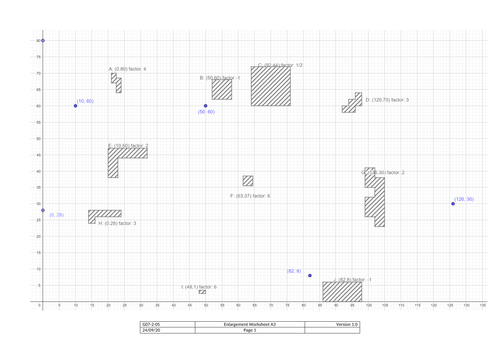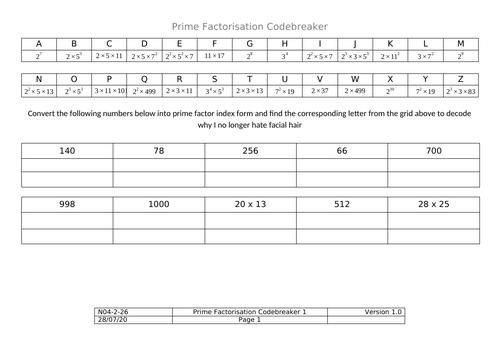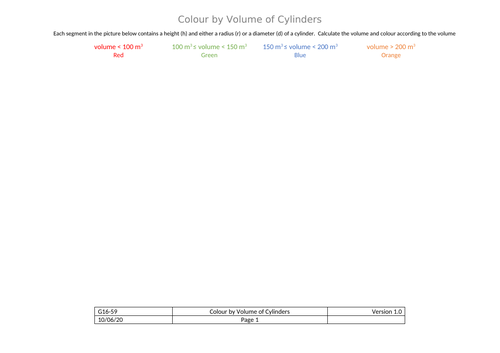
59Uploads
12k+Views
12k+Downloads
All resources

Shade by Directed Numbers
Shade (or don’t shade) the segments of the image based on whether the expression within evaluates to a positive or a negative number (directed number).
This resource also contains a second hidden hidden activity - shade the segments where the absolute value of the expression within is less than 20 to reveal a second (different) image).
Expressions are a mixture of addition, subtraction, multiplication and division.

Wheels - Simultaneous Equations
The inner and outer wheels combine to form 3 different equations. Turn the inner wheel to change the combinations and generate 3 different simultaneous equations in 2 variables. Find the wheel setting that solve consistently for the same values of a & b.
I’ve made each resource twice - once designed to be just printed and once where the inner wheels can be cut out and pinned to the outer wheels using paper fasteners (solutions can be found in the “cutting version”)
My main motivation in making this resource was to present a rich problem solving activity for the topic in a visually novel format.

Codebreakers - Metric Length Addition & Subtraction
Codebreakers in the format popular on TES. These are focused on adding and subtracting lengths given in different units (e.g. mm + cm).
There are three codebreakers attached - each with a (bad) joke. They gradually become more difficult in various ways
Both codebreakers require students to convert units by multiplying/dividing by 10, 100 or 1000. The third is more challenging to decode (the units in the key for the first codebreaker are all in metres, this is not the case for the third).

Codebreakers - Four Operations (in words)
A couple of codebreakers (in the format that seems very popular on TES) that I made for use with low ability yr 7 students built around completing simple arithmetic but with numbers presented as words instead of as numerals.
There are two codebreakers here - the second one is more difficult than the first.

Dials - Algebraic Factors
Use the clues to set each dial to the correct answer. Often individual dials can be set to two or more possible settings but each group of three has only one correct “setting”.
This particular worksheet is focused on factors and multiples of algebraic terms (with a few “clues” related to prime numbers and some related to square numbers).
The general idea behind these number dials is to provide a light revision activity but they may be useful in other situations. In particular I want students to begin to think about how to recognise whether an algebraic term is a square number and to contemplate what a multiple of an algebraic term can look like.
Answers are provided in the powerpoint file (this is not animated).
This worksheet follows on from the related (non-algebraic) worksheet:
https://www.tes.com/teaching-resource/resource-12538605

Plot Co-ordinates Superhero Picture
Plot the given co-ordinates to form an image of Ironman.
I’ve provided the same worksheet with 3 alternatives - one that forms the image entirely in the first quadrant, one that forms the image across the first and second quadrants and one that forms the image across all four quadrants.
This should allow for mild differentiation of the same activity.

Enlargement - Space Invader
An enlargment (with centre) worksheet. When enlarged the pieces form a “Space Invader”.
All co-ordinates are in the first quadrant. There are a couple of negative unit enlargements. The Geogebra file is included - however - should you wish to move everything to straddle the x & y axis.

Codebreaker - Ordering Directed Numbers
A codebreaker in the popular format based around ordering positive and negative numbers (directed numbers). Answering the questions and decoding provides the punchline to a bad joke (it was a freebie).
I’ve found plenty of other codebreakers online for directed numbers but none specifically on the foundational skill of ordering them so hopefully this is of use to someone out there.
There’s plenty of discerning understanding of place value (including decimals) with directed numbers and one question that involves fractions.

Wheels - Linear Equations between points
Turn the inner wheel to change the combinations of co-ordinates. Each combination of co-ordinates can be used to determine the equation of a straight line. Find the wheel setting that results in three straight lines that intersect at a single point.
I’ve made the resource twice - once designed to be just printed and once where the inner wheels can be cut out and pinned to the outer wheels using paper fasteners (solutions can be found in the “cutting version”)
My main motivation in making this resource was to present a rich problem solving activity for the topic in a visually novel format. There are a couple of extension questions for high ability students to consider.

Grid Fit - Evaluating Terms of Sequences
Fit the numbers and labels into the grid to form 6 different arithmetic sequences that satisfy the labels.
This is designed as a problem solving task for students who have been taught how to evaluate whether a given value is a term within a sequence.

Codebreaker - Evaluating Terms of Sequences
A codebreaker in the popular format. Students should evaluate the first/last term in a sequence to be greater than/less than a given amount etc. to decode the answer to a bad joke (I can’t put my book down because it’s about anti-gravity)
I had found plenty of other codebreakers on similar topics but not one specifically focused on evaluating terms so hopefully this is of use to people!

Capture the Squares Trigonometry
A series of ‘capture the squares’ games where the square value is the missing angle ABC. Angle ABC can often be determined by sketching the triangles and examining the sketch but it is intended that students use trigonometric ratios - specifically the task is intended to provide fluency work using the tangent ratio - to find the missing angle.
Can be used to consolidate learning or as bell work.

Codebreaker - Prime Factorisation
A codebreaker in the popular format. Students should convert numbers into prime factor index form to decode the answer to a bad joke (I no longer hate facial hair because it grew on me).
I had found plenty of other codebreakers on similar topics but not one specifically on prime factorisation so hopefully this is of use.

Capture the Squares - Averages
Capture the squares is a game intended for 2-3 players. Each takes turns drawing a horizontal or vertical line. When the fourth line around a square is drawn on the page, the player who placed that line takes the square.
The maths twist is that the squares have different values. Players must solve the expression inside the square to find the value. In this case the value of squares is found by calculating the average of 3-5 values.
Worksheets escalate in difficulty. Starting with positive & negative integers and then moving through 1/2 fractions and then onto fractions/decimals as small as 1/4 increments.

Capture the Squares - Coins
Capture the squares is a game intended for 2-3 players. Each takes turns drawing a horizontal or vertical line. When the fourth line around a square is drawn on the page, the player who placed that line takes the square.
Each square on this worksheet is a coin.

Coins search
Like a word search - but with coins.
Find a total amount by drawing a horizontal, vertical or diagonal line through 3, 4, 5 or 6 consecutive cells.
The worksheet has questions of increasing difficulty and includes a set of possible solutions (there are other options for some of the questions). Also includes a PowerPoint that has the solutions highlighted on it.

Colour by Volume of Cylinders
Colour each segment of the image according to the volume of the cylinder described within.
Particularly designed for students who struggle to engage with traditional worksheets but approrpriate for any students seeking light revision.

Capture the Squares Ratio Simplification
A series of ‘capture the squares’ games where the square value is the missing number in a ratio to simplify.
Can be used to consolidate learning or as bell work.
Games start basic but later ones build to include three part ratios.

Multiplication Mazes
Move from square to square - only if the equation within is true. Find the path through from the top left hand corner to the bottom right.
Incorrect equations are mostly the result of misconceptions in implementing grid method (although some are misconceptions from column method).

Colour by Distance Between Co-Ordinates
Each segment contains two co-ordinate pairs. Work out the distance between the two using Pythagoras’ theorem and colour the segment according to this distance.
The resource does allow for co-ordinates in all 4 quadrants and may therefore challenge foundation level students but all triangles are Pythagorean triples with integer value lengths for the hypotenuse.




















